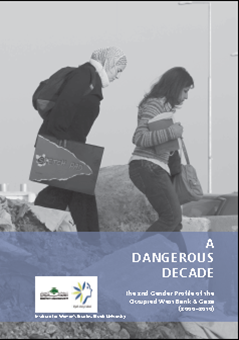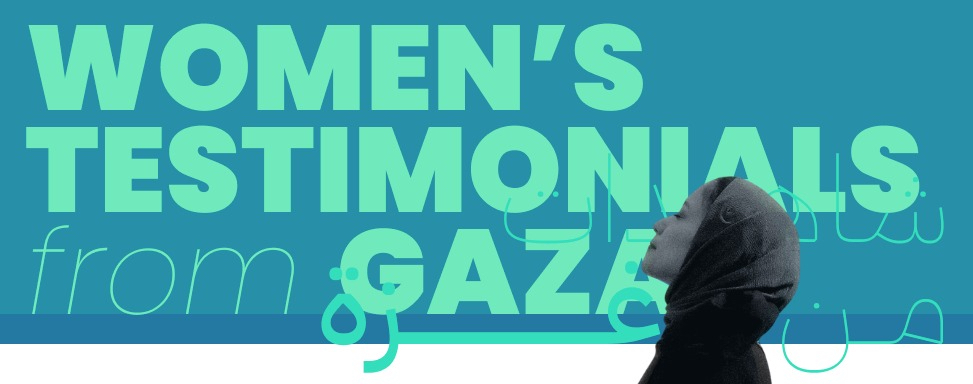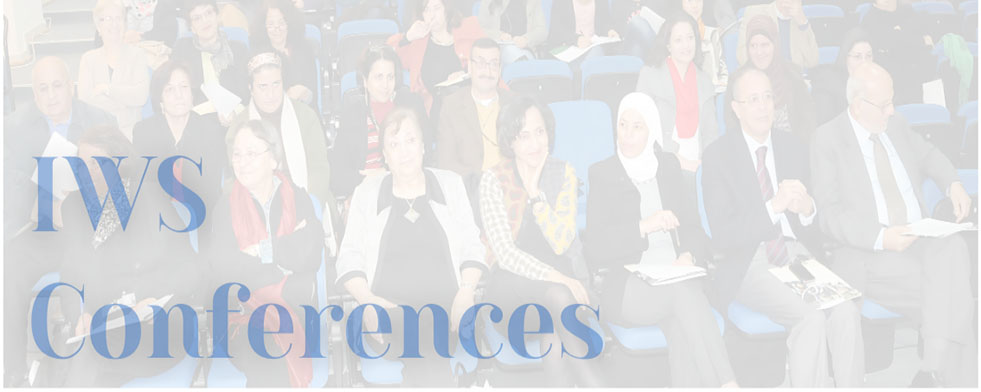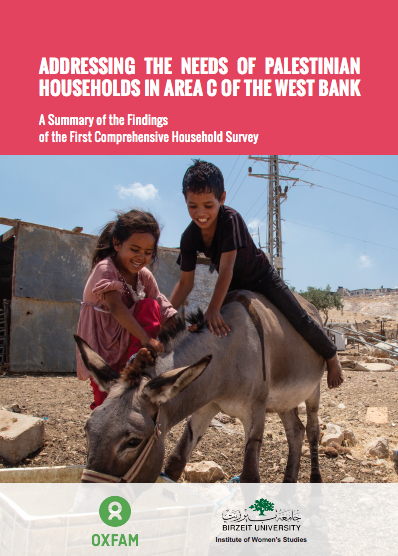The 2nd Gender Profile is an attempt to "see where we are now" both in terms of the evolution of gender relations since the collapse of the peace process as well as in re-thinking our research agendas in current contexts. The Profile has involved a wide-spread and in-depth review of the data and literature on developments and trends in the oPt over the past decade. While there has been a glut of reports written at various stages of the decade-long crisis in the oPt, few have tried to pull the implications of them together into a larger picture and even fewer have tried to understand where gender relations fit into this larger political-economic picture. IDRC support for the Institute's work on the Profile has enabled the Institute to take on this task. It further allowed us to integrate the dispersed, small-scale ethnographic findings on gender into building a larger picture of how Palestinian society and its gender relations have been re-shaped under the impacts of the multi-layered crisis of the last ten years. We are thankful to the IDRC for its support in this project. We would also like to express our appreciation for the many women and men who have engaged with us in this process whether in their capacity as government officials and representatives, representatives of local or international NGOs, academics or activists.
The 2nd Gender Profile includes:
1. An introductory chapter on current contexts:
"Introduction: A Decade of Catastrophe" /by Rema Hammami
2. A chapter on population and health:
"No Palestinian Is Safe: Population Dynamics and the Well-Being of Men, Women and Children through Objective Measures and Subjective Indicators"/ by Rita Giacaman
3. A chapter on poverty:
"The Pauperization of Palestinian Women, Men and Children in the West Bank and Gaza Strip" /by Jamil Hilal
4. A chapter on violence and security:
"Violence, Gender-Based Violence and Protection: A Dangerous Decade" /by Penny Johnson
5. A chapter on labour and the economy /by Samia Botmeh
6. A chapter on political participation /by Islah Jad
7. A chapter on education /by Eileen Kuttab
1. Background to the Profile
The 1st Profile
In August, 1999, the Institute of Women’s Studies (IWS) at Birzeit University, with the support of SIDA Sweden, undertook a profile on Palestinian women in the occupied territories. The profile brought together data and scholarship in an accessible form in order to communicate the salient gender issues and gender gaps in Palestinian society to the wider gender rights and policy community at the time. The rationale behind it was based on IWS’s experience of the communication gap between its role as researchers and the complex political field of donors, ministries, NGOs and activists with their various and often contradictory agendas regarding gender in the Palestinian context.
The wider political context for this profile was the ongoing momentous transformations taking place in the West Bank and Gaza during the “interim period” initiated by the Oslo Peace Process of 1994. IWS came into being just as this deeply conflictual and contradictory process took off. On the one side was a long legacy of popular and mass based political activism in which women’s movements and women’s agendas were part of a larger national movement, and on the other was the creation of a Palestinian government (the Palestinian Authority) with its various institutions and the large-scale entry of international donor agencies and global development agendas into the Palestinian context for the first time.
As far back as 1995, the IWS had undertaken a series of in-depth sectoral profiles on Palestinian women – primarily using gender dis-aggregated data being produced by the newly formed Palestinian Central Bureau of Statistics (PCBS). One social overview and four sectoral profiles were published (health and fertility; education; labour and economy; law and human rights; politics and government) over the next two years.
While the sectoral profiles were useful – it was clear that a synthesis was necessary – both for IWS to articulate more clearly the link between data analysis and policy strategies and constraints and for the wider gender rights and policy community to have an accessible overview of the main gaps along with their social and policy implications, as well as institutional trajectories. Thus the profile was not simply a research review but a multi-pronged process that also involved:
- Mapping the various components of the “national machinery” and attempting to understand both the synergies and contradictions between them.
- Assessing the scope and limitations of various initiatives and frameworks that had become the “common sense” of donors, government and the women’s rights community as a whole.
- Opening a dialogue between these various actors on women’s rights towards building a more context specific and relevant gender strategy that could bring together the two often dichotomous approaches taken towards gender equity: developmental frameworks with rights frameworks
Thus extensive interviews were undertaken with NGOs, officials in key ministries of the Palestinian Authority and international donors while the final findings of the report were shaped by a collective discussion with 25 leading actors from these backgrounds at a final seminar. The outcome of these discussions was integrated throughout the profile, while the institutional and policy setting were presented in three final annexes of the report.
The final product, Towards Gender Equality in the Palestinian Territories: A Profile on Gender Relations, began with an “executive summary” and introduction. This was followed by, “Palestinian Society in the West Bank and Gaza” – a chapter which attempted to provide a historical overview of main political economic process that shaped the society of the West Bank and Gaza Strip since 1948 and how these shaped gender relations and constraints.
The 2nd Profile
Following 2000, the context of state building and development that framed IWS’s focus in the 1st Gender Profile) collapsed and Palestinian society was plunged into an unprecedented state of protracted crisis whose destructive and transformative effects have continued to unfold throughout the period during which this research project was implemented. The main research problem of the 2nd Gender Profile was therefore to try and understand how the multi-dimensional and protracted crisis had affected various aspects of gender relations (across various sectors) as well as re-shaped the priorities of gender policy and opportunities for gender rights interventions in the oPt.
The main contours of this crisis include:
- An ongoing context of sustained violent/ armed conflict with traumatic peaks, the most notable being Israel's war on Gaza in December 2008 - January 2009. The violence of Israeli military actions has also led to internal political violence, especially in Gaza.
- Economic collapse brought about through Israeli militarily imposed economic sanctions and intensified by international sanctions imposed on the Palestinian Authority.
- The near collapse of state institutions due to sanctions, mobility restrictions and laterally -- internal political conflict.
- Israel's imposition of an extreme regime of mobility restrictions on the civilian population composed of hundreds of military checkpoints and barriers and consolidated by the separation wall and underpinned by a complex permit system governing all aspects of Palestinian life and well-being from family and social life to education and health and all forms of economic activity.
At the start of the project in 2007, IWS noted "the overall situation remains dire – with the most burning issue being the separation of the Palestinian polity into two contending governments split between the West Bank and Gaza. This has had much worse consequences for Gaza where profound social and economic collapse is being hastened by international and Israeli sanctions." By 2007 -- even before Operation Cast Lead in December 2008 -- the crisis across the oPt was seismic, comprehensive and continuous. All sectors of the society and polity had been engulfed by it – leading to a situation in which the institution-building and development focus prior to 2000 have largely given way to humanitarian relief and emergency aid and crisis management. A year later, the situation had been exacerbated to previously unimagined levels by the brutal war on Gaza and the cumulative repercussions of the ongoing siege there.
Over the period of crisis, the focus of IWS’s various research projects attempted to address different aspects of the new crisis context and its unfolding implications for gender. Between 2000 and 2007, much of our research orientation came to focus on the issue of survival -- be it at the individual, household or community level. In particular, IWS attempted to understand how crisis effects gender roles and differentially shapes survival strategies and outcomes. During this period IWS undertook various ethnographic studies to try and understand these dynamics. For instance, undertaking extensive qualitative studies to try and understand how families react in the first instance to war (and building on our findings from our 1999 IDRC-supported community household survey). This was then followed up with studies on the gender impact of armed violence, the gender impact of the separation wall, a more in-depth study of three Ramallah area communities in responding to crisis (also supported by IDRC), as well research on survival strategies and mobility restrictions created by military checkpoints. While overwhelmingly our research focussed on how society responds to crisis in all its aspects – and how these are shaped by gender dynamics – we also attempted to open a debate about the ongoing role of the women’s movement and issues of gender equity during the crisis. As such, Institute members also undertook a study and series of workshops with gender rights movement activists in the West Bank and Gaza, within Israel and in Jordan – to try and map out a common vision for the current period.
For the first few years of the second Intifada, international donors and agencies moved into emergency mode and humanitarianism came to displace development. In addition, interest in gender issues among aid agencies went onto the back burner, as physical destruction from the Israeli military was followed by the need to deal with issues of health and food crises, homelessness and spiralling poverty rates. Added to this, the Palestinian women’s movement also went into political retrenchment – continuing on its programmatic work institution by institution but not mounting a public, mass-based gender rights campaign (the one exception being various campaigns promoting women’s candidature in the 2005 PLC and municipal elections). The Palestinian Authority’s most sustained contribution to gender equity during this period was also around the PLC and municipal council elections – creating gender quotas for both. The Authority also changed the institutional structure for gender mainstreaming – by creating a separate Ministry of Women’s Affairs during the same period. In both cases (the quota and the creation of a separate ministry) these changes unfortunately took place in the context of ongoing factional conflict between Fateh and Hamas -- thus undermining their full potential.
As such, the profound changes in the context over a sustained period led to a multi-pronged challenge in terms of gender research. On the one hand was trying to understand the larger ways in which gender relations in the society had not only coped with crisis in the short-term, but had over time been transformed by it. And on the other was the need to understand more systematically the impacts of this changed environment on the strategy, vision and roles of different policy and political actors (Donors, Government and women’s movement) in terms of gender initiatives (or lack of them). In short, by 2007, IWS researchers felt strongly that it was time for a stock taking of how gender relations, issues and actors had been re-shaped and re-organized through the conflict so as to build solid research and policy priorities for the immediate future.
2. Methodology
As a review and mapping exercise of “where we are,” the Profile primarily depended on a comprehensive review of existing research and data. These were augmented by individual in-depth interviews undertaken with policymakers in a number of areas, as well as actors in the field, and – where needed – focus group interviews. As such, the research embraced a set of complementary, mixed methodologies appropriate to each area of exploration.
Reviews of existing literature and data included: analysis of a wide range of existing data sets from the Palestine Central Bureau of Statistics (PCBS), policy publications by various ministries, as well as by local and international NGOs and agencies operating in the oPt tasked with assessing the various impacts of the crisis across different sectors. Just to give a few examples, these included: OCHA’s on-going assessment of mobility restrictions, the World Bank’s economic assessments; and the Palestinian Ministry of Health’s, as well as WHO reports on health and fatalities. These were used both as data sources, as well as critically assessed in terms of how they approached gender (many international agencies providing very little disaggregated data on gender and often being gender blind in their analysis). In addition, researchers pulled together findings and insights from a wide-range of academic studies treating various communities and aspects of the crisis – including from our own ethnographic findings over the decade, but also including the work of other feminist and other scholars.
Individual interviews were undertaken with actors as diverse as policemen, officials in the Ministry of Women’s Affairs, and women’s rights activists while focus groups were undertaken specifically in relation to understanding gendered perceptions of violence in a number of communities.
IDRC support was pivotal in enabling such a wide-spread and in-depth review of the data and literature on the oPt's decade long conflict -- as well as enabling us to integrate the dispersed small scale ethnographic findings on gender into building a larger picture of how Palestinian society and its gender relations have been re-shaped under the impacts of the multi-layered crisis of the last ten years.
Download




